Sheet metal e-coating, also known as electrocoating, is a process where an electrically charged coating is applied to a metal surface. This process is essential for protecting metal parts from corrosion and enhancing their appearance. Effective quality control in e-coating involves several steps and techniques to ensure that the final product meets both aesthetic and performance standards. Here’s a comprehensive guide to e-coating quality control:
1. Understanding the E-Coating Process
E-Coating Steps:
Pretreatment: The metal surface is cleaned and prepared for coating, which usually involves degreasing, phosphating, or iron-phosphate treatments.
Electrocoating: The metal parts are submerged in a bath containing the coating material and an electric current is passed through the bath to deposit the coating onto the metal.
Rinsing: The coated parts are rinsed to remove any excess coating.
Curing: The parts are heated to cure the coating, making it hard and durable.
2. Key Quality Control Parameters
1>. Pretreatment Quality:
Inspection of Pretreatment: Ensure that the cleaning and phosphating processes are effective. Look for cleanliness and uniformity.
Chemical Analysis: Regularly test the pretreatment solutions for concentration and pH levels.
2>. Coating Thickness:
Measurement Techniques: Use a magnetic or eddy current gauge to measure coating thickness. The thickness should be consistent with specifications.
Test Locations: Check multiple spots on the part to ensure uniform coating.
3>. Coating Adhesion:
Adhesion Testing: Perform tests like the cross-hatch adhesion test or the pull-off adhesion test to ensure that the coating adheres well to the metal substrate.
4>. Coating Appearance:
Visual Inspection: Look for defects such as runs, sags, or uneven coverage.
Gloss Measurement: Measure the gloss level to ensure it meets the specifications.
5>. Coating Consistency:
Film Quality: Check for uniformity, including the presence of bubbles, pinholes, or craters.
Color Consistency: Verify that the color matches the specification.
6>. Curing Quality:
Temperature Monitoring: Ensure that the curing oven maintains the proper temperature profile.
Curing Time: Verify that the parts are cured for the correct duration to achieve the desired properties.
7>. Corrosion Resistance:
Salt Spray Test: Conduct a salt spray test to evaluate the coating’s resistance to corrosion.
Environmental Testing: Perform additional environmental tests if required, such as humidity or temperature cycling tests.
8>. Electrical Conductivity:
Conductivity Testing: Ensure the coating does not interfere with the electrical properties of the metal parts.
3. Quality Control Procedures
1>. Establish Inspection Criteria:
Develop specific criteria for each quality control parameter based on industry standards and customer requirements.
2>. Regular Audits:
Perform regular audits of the e-coating process to identify and address any issues.
3>. Documentation and Reporting:
Maintain detailed records of inspection results, testing procedures, and corrective actions taken.
4>. Training and Competence:
Ensure that all quality control personnel are properly trained and competent in their roles.
4. Common Defects and Solutions
DefectPotential CausesSolutionsUneven CoatingPoor bath circulation, incorrect voltageAdjust circulation, calibrate equipmentPinholes or BubblesImproper part cleaning, high coating viscosityImprove cleaning, adjust coating parametersPoor AdhesionInadequate pretreatment, improper curingEnhance pretreatment, verify curing processColor VariationsInconsistent batch materials, process changesEnsure consistent material sources, control process variables
5. Best Practices for E-Coating Quality Control
1>. Automated Systems:
Where possible, use automated systems for pretreatment, coating, and curing to ensure consistency and reduce human error.
2>. Continuous Improvement:
Regularly review and update processes based on the results of quality control checks and feedback from customers.
3>. Engage with Suppliers:
Work closely with suppliers to ensure that all materials used in the e-coating process meet quality standards.
4>. Compliance with Standards:
Adhere to industry standards such as ISO 9001, ISO 14001, and any specific standards relevant to e-coating.
5. Tools and Equipment for Quality Control
Coating Thickness Gauge: For measuring the thickness of the e-coating.
Adhesion Test Kit: For checking the adhesion of the coating.
Gloss Meter: For measuring the gloss level of the coating.
Salt Spray Chamber: For testing corrosion resistance.
Environmental Chamber: For conducting environmental tests.
pH Meters and Chemical Test Kits: For analyzing pretreatment solutions.
6. Quality Control Checklist
TaskFrequencyResponsible PartyInspect pretreatment processDailyQuality InspectorMeasure coating thicknessEach batchQuality InspectorPerform adhesion testsEach batchQuality InspectorCheck coating appearanceEach batchQuality InspectorTest for corrosion resistanceMonthlyQuality InspectorMonitor curing processEach batchProduction SupervisorVerify environmental conditionsDailyMaintenance Technician
By adhering to these practices and maintaining a rigorous quality control regime, you can ensure that your e-coating process produces high-quality, durable, and aesthetically pleasing products.
china sheet metal fabrication manufacturers | sheet metal fabrication company china | china sheet metal fabrication companies | china sheet metal forming manufacturers | china sheet metal fabrication factory | china metal enclosure manufacturers | china sheet metal fabrication supplier | china custom sheet metal parts | china sheet metal parts company | china precision sheet metal manufacturer | china sheet metal parts manufacturers | china sheet metal manufacturing manufacturers | Folded Sheet Metal Box
